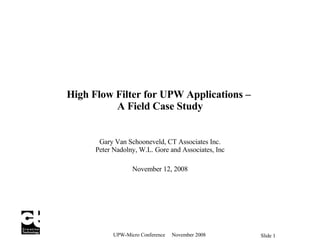High Flow Filter for UPW Applications ŌĆō A Field Case Study
- 1. High Flow Filter for UPW Applications ŌĆō A Field Case Study Gary Van Schooneveld, CT Associates Inc. Peter Nadolny, W.L. Gore and Associates, Inc November 12, 2008
- 2. Critical feature sizes of current and developing semiconductor devices continue to drive the need for improved filter retention of particles smaller than 50 nm. Improvements in the retention of small particles in ultrapure water filters have typically come at the expense of increased pressure drop across the filter. Recent advances in membrane materials and structure has resulted in filters with improved particle retention and reduced pressure loss. This paper will review the performance of a newly developed 20 nm filter from WL Gore installed in a ultrahigh purity water system. Introduction
- 3. Presentation Outline Filter description and selection Water system description Post installation rinse-up measurements Particle and pressure drop performance 6 month performance check Summary
- 4. Case Study Filter Description 10ŌĆØ Cartridge Media ŌĆō Hydrophilic expanded PTFE Supports and Housing ŌĆō Polypropylene O-rings ŌĆō Viton Type 2-222
- 5. Screening Tests ŌĆō Filter Rinse-up
- 6. Screening Tests ŌĆō Filter Retention The test is a modified version of SEMATECH Provisional Test Method for Determining Particle Contribution and Retention by UPW Distribution System Components (1992). Technology Transfer Number 92010949B.
- 7. Filter Performance Comparisons Filters tested at 10 liters per minute flow rate. 300 x 10 6 100 x 10 6 3 x 10 6 Particles Released After Flow Stoppage ( ’é│ 50 nm) 2.6 psid 2.2 psid 0.7 psid Pressure Drop @ 10 LPM > 90% > 99.9% > 99.9% Filtration Efficiency ŌĆō PSL Challenge ( ’é│ 50 nm) < 50 hours < 35 hours < 3 hours Non-Volatile Residue Rinse volume (0.1 ppb added) < 1 hour < 1 hour < 1 hour Resistivity Rinse Volume (0.1 M ’üŚ -cm added) < 40 hours < 40 hours < 40 hours TOC Rinse Volume (0.1 ppb added) < 30 hours < 30 hours < 30 hours Particle Rinse Volume (1 count added ’é│ 50 nm) Supplier B - 40 nm (PES) Supplier A - 20 nm (Polysulfone) GORE ’āż 20 nm High Flow Filter Attribute
- 8. High Purity Water System Schematic
- 9. High Purity Water System 18.1 M ’üŚ - cm Resistivity 40 ŌĆō 100 ppb Total Organic Carbon (TOC) < 1 count/mL ’é│ 100 nm Particle Concentration Typical Performance Parameter
- 10. UPW System Schematic (before case study filter installation)
- 11. Ultrahigh Purity Water System 20 Flow Rate (Lpm) 0.27 Operating Pressure (MPa) < 1 Non-Volatile Residue (ppb) 18.2 Resistivity (M ’üŚ ŌĆō cm) < 1 Total Organic Carbon (ppb) < 0.05 Particle Concentration (# /mL ’é│ 100 nm Typical Performance Parameter
- 12. Case Study Details The average flow rate for the water system at the time of the filter installation was 20 Lpm (4.5 gpm). The outlet pressure after the water system final filter was 0.26 MPa (37 psi). The water temperature was 27 o C. The filter was installed in the final filter position replacing the 0.05 ’üŁ m filter in October 2007.
- 13. UPW System Schematic (after case study filter installation)
- 14. Case Study Instrumentation Sentra 0 ŌĆō 10 psi ’üä P sensor Filter housing vent ports Pressure Drop Thornton Model 200CR End of loop Resistivity Fluid Measurement Technologies Model 7700 NRM End of loop Nonvolatile residue G.E. Sievers Model 500RL End of loop TOC PMS M50 Into test filter Particle concentration PMS UDI 50 (x2) End of loop Out of filter Particle concentration Instrument Location Property
- 15. Test Results
- 16. TOC Rinse-up
- 17. NVR Rinse-up
- 19. Particle rinse-up after filter installation ŌĆō first 100 hours
- 20. Particle rinse-up after filter installation (10 ŌĆō 480 hours) Average particle concentration, 430 - 480 hours: 0.057 per mL ’é│ 50 nm 0.015 per mL ’é│ 100 nm
- 21. Filter Rinse Measurements Flushing times required to achieve NVR and TOC cleanliness levels Flushing times required to achieve inorganic cleanliness levels Flushing times required to achieve particulate cleanliness levels
- 22. Performance Improvement ŌĆō Particles
- 23. Performance Improvement ŌĆō Pressure Loss
- 24. Particle levels 6 months after installation (exiting the filter) Particle concentration - 100 hour average : 0.041 per mL ’é│ 50 nm 0.013 per mL ’é│ 100 nm
- 25. Filter Case Study Summary (1) A 0.05 ’üŁ m filter was replaced with a 20 nm expanded hydrophilic PTFE filter in this case study. Particle concentrations ’é│ 50 nm and ’é│ 100 nm at the end of the supply loop were reduced 62% and 55% respectively when measured 100 hours after filter installation. Pressure drop across the filter was reduced by over 90%. Non-volatile residue recovered to 1 ppb added within 20 minutes of rinsing.
- 26. Filter Case Study Summary (2) TOC recovered to 1 ppb added within 45 minutes of rinsing. Resistivity recovered to 0.1 M ’üŚ -cm with 5 minutes of rinsing. Particle concentrations out of the filter ’é│ 50 nm and ’é│ 100 nm achieved one count/mL within 150 and 75 minutes of rinsing respectively. Particle concentrations out of the filter measured 6 months after filter installation were slightly lower than the concentrations measured at 480 hours.

























